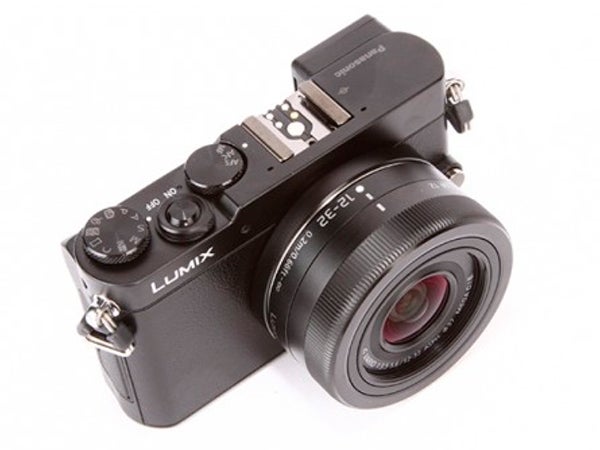Panasonic Lumix DMC-GM5 Review
Panasonic Lumix DMC-GM5
A tiny compact system camera that comes up short

Sections
- Page 1 Panasonic Lumix DMC-GM5 Review
- Page 2 EVF, Screen and Features Review
- Page 3 Image Quality, Video and Verdict Review
Verdict
Pros
- Good image quality thanks to MFT sensor
- Tiny body
Cons
- Poor battery life
- Fiddly controls
- No 4K video
Key Specifications
- Review Price: £769.00
- 16-megapixel Micro Four-Thirds sensor
- 1,166k dot EVF
- 3-inch 921k dot screen
What is the Panasonic Lumix DMC-GM5?
The Panasonic Lumix DMC-GM5 is a second go at a formula established last year with the DMC-GM1: an absolutely tiny camera body that offers a fairly large Micro Four Thirds sensor and interchangeable lenses. Starting at £699 with a kit lens, Panasonic hasn’t dumbed down the features to meet a lower price in this second attempt.
Instead, the Lumix GM5 adds an EVF and bulks up the body a bit to try and address the main criticism of the GM1 – that it’s just too fiddly. For all its efforts, the DMC-GM5 is still pretty cramped, and awkward at times, but if a slim and light frame is at the top of your list, this is about as petite as compact system cameras with large sensors get.
Panasonic Lumix DMC-GM5 – Design
The look of the Panasonic Lumix DMC-GM5 may not be too attention-grabbing, but make no mistake: the outer hardware is what this camera is here for. With a body measuring 98.5 x 59.5 x 36.1mm it’s tiny for a Micro Four Thirds model.
It’s 5.4mm wider and 5.7mm taller than the GM1, but when you consider the extras it packs in, that’s not a great deal larger. How small is it? It’s 16mm less long, 6mm shorter and 19mm thinner than the Panasonic Lumix LX100, which is a bona-fide compact camera.
This thing is very small indeed, although you have to remember that it’ll need a lens to be of any use to anyone. Lens choice becomes crucial, because if you go for something too large, the Panasonic DMC-GM5 loses much of its appeal. A compact overall package is key.
SEE ALSO: Best Cameras Round-up
Of course, Micro Four Thirds lenses are generally smaller than those of APS-C compact system cameras such as the Sony Alpha a6000, a somewhat comparable alternative. The GM5’s standard kit lens is the same 12-32mm unit bundled with the GM1, and offers a focal range equivalent to 24m-64mm – fairly good as an everyday lens. It’s very petite, although with a maximum aperture of f/3.5-5.6 it doesn’t offer the creative control over depth of field you get with some others.
For those with greater demands, the DMC-GM5 is also available with the Leica 15mm f/1.7 lens (30mm equivalent), which will naturally give you much greater shallow depth of field potential, as well as better low-light flexibility. This bundle will cost you as much as £1049, though – a hefty premium. You may want to consider the cheaper Panasonic 20mm f1.7 as an alternative.
As you really need a very compact lens to make the very most of the Panasonic DMC-GM5’s design, only a handful of lenses are truly suited to it — although any MFT lens will work. Given this, consider whether a large-sensor-small-body compact such as the Lumix LX100 or Sony RX100 III might be a better fit. 
As you’d expect of a £700 camera, the Panasonic GM5 is thoroughly well-made, with a magnesium alloy body and textured front plate in place of a contoured handgrip. We did find handling the thing slightly precarious at times because of its small size and near grip-free design, but it’s largely a case of getting used to its body. Those used to smaller cameras may find its 211g weight unnervingly light, but that’s a positive for a camera of this style.
There is a small thumb grip on the back, thankfully, and if you really must have a larger grip, Panasonic sells one that screws in for £99. But buying such a thing might be considered an admission of having made the wrong camera choice in the first place. 
In an effort to make the Panasonic DMC-GM5’s handling a bit better than the older GM1, Panasonic has redesigned the camera’s controls. You don’t get full-on manual controls like you do with the Lumix LX100, but the main dial’s been moved from its position around the rear D-pad to above it, separating the two.
It’s an improvement, but unfortunately not a particularly drastic one. We still found the DMC-GM5 quite cramped in use, especially when trying to compose through the EVF. There just isn’t enough room, and as an interchangeable-lens camera it can’t rely on lens dials to provide manual controls. Using the touchscreen does alleviate the problem, but not quite enough.



